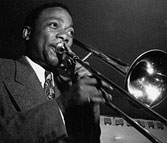By Chris Wiley
Who translated Louis Armstrong’s innovations for the trombone? When the question comes up, which is infrequently, the names usually given in answer are Jimmy Harrison or Jack Teagarden. But J.C. Higginbotham, while still managing to sound like himself, adapted many of Satchmo’s ideas to the slide.
Higginbotham was born in Atlanta Georgia in 1906, but raised in Cincinnati Ohio. By 1924, while still living in Ohio, Higginbotham was playing professionally in a band led by Wes Harvey. In the next two years, “Higgy” traveled to Buffalo, New York, where he worked with Eugene Primos and another pioneer jazz trombonist, Jimmy Harrison.
J.C. Higginbotham Sound Clips
- Dallas Blues
- Recorded with Luis Russell’s band, December 10, 1929
- St. Louis Blues
- Recorded with Luis Russell’s band, December 29, 1929
These sound clips are provided for educational purposes only.
Not surprisingly, J.C. eventually made it to New York City, where he joined Luis Russell’s band in 1928. Russell’s jazz band was known as one of the hottest in the city, and this reputation was underscored in 1929 when Louis Armstrong visited from Chicago just to record with the group. Russell had a knack for finding strong players, and many of the sides that feature Armstrong also contain excellent solos by Higginbotham. On these sides with Russell, J.C.’s style is robust, sure-footed, and forceful. If Higginbotham is not too subtle here, he is always in control of the instrument, and his sense of rhythmic timing is as solid as his sound. On St. Louis Blues, notice how J.C. uses his flexibility up and down the slide as solo material for the break.
In 1931, Higginbotham left Russell and briefly joined Chick Webb’s band. (Chick Webb, a swinging hunchback drummer, later had the good fotune of hiring Ella Fitzgerald to sing with his band.) Membership in Fletcher Henderson’s pivotal group was next, where J.C. stayed until 1933. Higginbotham’s next extented jobs included Mills’ Blue Rhythm Band (1934-36) and Louis Armstrong’s band (1937-40).
Throughout the 40s, Higginbotham played in Boston and New York City and often worked with Henry “Red” Allen, who was never far from J.C. throughout his career. Like Higginbotham, Red Allen is often not sufficiently appreciated, but he is one of the few trumpet players who could parry with Louis Armstrong in the same style.
Like many jazz musicians of his generation, Higginbotham was later associated with a “dixieland-style” and the dixieland revival of the 50s. But although he led or played in bands in the Dixieland vein, Higginbotham’s background was more varied, and his true role as one of the swing trombone pioneers is often obscured in jazz histories.

